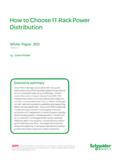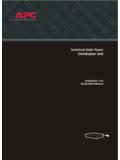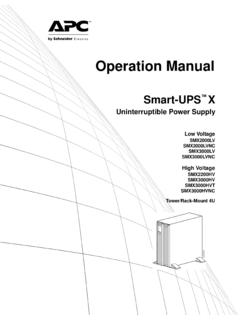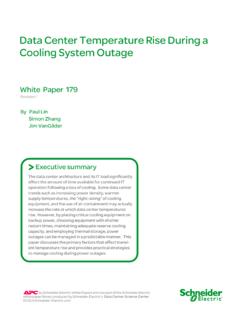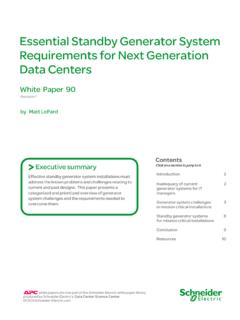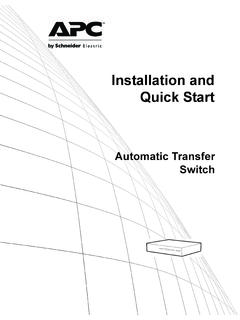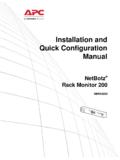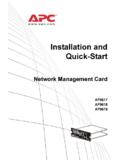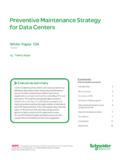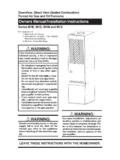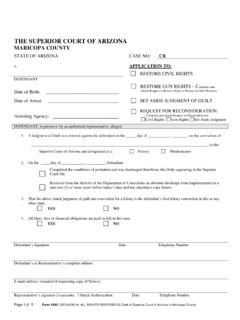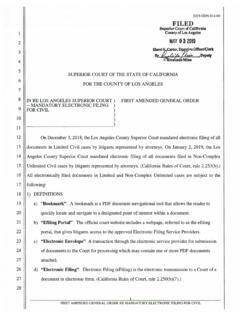Transcription of The Different Types of Cooling Compressors - apc.com
1 The Different Types of Cooling Compressors Executive summary There is much confusion in the marketplace about Different compressor Types and their characteristics. In this paper, each of these Compressors is defined, benefits and limita-tions are listed, and practical applications of each are discussed. With this information, an educated decision can be made as to most appropriate compressor for a given need. Revision 0 White Paper 254 by Paul Lin Victor Avelar Schneider Electric Data Center Science Center White Paper 254 Rev 0 2 The Different Types of Cooling Compressors A compressor acts as the heart of a refrigerant-based mechanical Cooling system. Its functions include drawing in the cool vaporized refrigerant that carries the heat energy from the evaporator coils, compressing it from a low pressure and tempera-ture to a high pressure and temperature, and pushing it around the refrigeration loop for the purpose of heat rejection.
2 For more information on fundamentals of the refrigerant-based mechanical Cooling system, see White Paper 57, Fundamental Principles of Air Conditioners for Information Technology. In data center environments, the compressor type not only impacts first cost and operational characteristics of the Cooling system ( performance, reliability, life-span, noise, etc.) but also impacts the capacity requirements of upstream power distribution equipment and generators, required to support the Cooling system. However, the various compressor Types and their attributes often cause confusion for data center managers and operators. For example, it is widely believed that there are only two Types of Compressors , namely constant speed and variable speed . These two commonly used terms do not correctly describe many of the Compressors available and cannot explain the characteristics of each of the com-pressor Types .
3 Further adding confusion, vendors routinely produce models with similar names, but with very Different performance characteristics. White Paper 257, Difference Between Variable Speed and Variable Capacity Compressors and Why It s Im-portant shows an example with quantitative analysis. Much of this confusion goes away if the Different Types of Compressors are properly identified. This paper classifies the compressor Types in the marketplace today, describes their structure, theory of operation, benefits, limitations and applications, along with comparisons showing capacity, efficiency, and cost differences. Compressors are sometimes described by the following characteristics: Drive speed (constant speed or variable speed) Number of stages (single-stage, two-stage, or multi-stage) Drive Types (motor, engine, belt, or chain, etc.) Structure (open type, semi-hermetic and hermetically sealed) Cooling method and medium (air-cooled, water-cooled, or oil-cooled) Lubricating method (splash lubricated, forced lubricated, or oil-free) However, the above characteristics cannot distinguish the commonalities or unique characteristics among the Different compressor Types , which leads to confusion for data center managers and operators.
4 In fact, the most typical classification is based on the compressor theory of operation, such as positive displacement and dynamic (see sidebar for detailed explanations). Figure 1 shows the typical classification of compressor Types based on their theory of operation. Not all Types , but most of the common Types are listed here. This pa-per discusses five compressor Types which are commonly installed in data center Cooling systems (in green). The following sub-sections defines each compressor type, and lists the benefits, limitations and applications of each compressor type in details. Introduction Compressor Types Positive displacement vs. dynamic Positive displacement means that the cool vapor refrigerant is compressed to a high pressure and temperature via a chamber whose volume can change. For example, the motion of a piston in a cylinder chamber, or the ro-tation of a vane in a cylinder chamber, or the rotation of two matching helical screws inside of a casing, etc.
5 Dynamic means that the cool va-por refrigerant is compressed to a high pressure and tempera-ture by adding kinetic energy via a rotating component. For example, a spinning impeller, or a rotating blade, etc. Schneider Electric Data Center Science Center White Paper 254 Rev 0 3 The Different Types of Cooling Compressors Compressor TypesPositive DisplacementDynamicReciprocatingRotaryCe ntrifugalLobeVaneScrollLiquid RingAxialScrewDiaphragmSingle-ActingDoub le-Acting Reciprocating compressor (single-acting) A reciprocating compressor is also called a piston compressor which adopts the back and forth piston motion in a cylinder synchronized with suction and discharge valves to compress the vaporized refrigerant from a low pressure and temperature to a high pressure and temperature (shown in Figure 2). The motion of the piston is achieved via a crankshaft which converts motor rotations to piston reciprocations.
6 Cut-away View Theory of OperationCompression PartPistonCylinderMotor statorMotor rotorSuction pipeDischarge pipeCrankshaftCasingPistonCylinderSuctio n valveSuctionCompression & DischargeConnecting rodCompression partDischarge valve Each operation cycle includes three actions: suction, compression and discharge. Each crankshaft rotation can achieve these three actions in sequence; as a result , the gas displacement is discontinuous which causes vibration. The total theoretical gas displacement depends on the size of each cylinder, cylinder quantity, and the rotating speed of the crankshaft. However, the actual gas displacement is also de-termined by the volume efficiency which depends on clearance volume (see side-bar), resistance of suction and discharge valves, leakage between the piston and cylinder, etc. Depending on the location of the working fluid, the reciprocating compressor can be sub-classified as single-acting or double-acting.
7 Single-acting means that the refrigerant acts only on one side of the piston while double-acting means the work-ing fluid acts on two sides of the piston. The diaphragm compressor in Figure 1 is normally used to compress hydrogen and natural gas and is not discussed in this paper. Figure 1 Classification of Cooling compressor Types based on the theory of operation (Green shows the compressor Types commonly installed in data center environ-ments) Clearance volume Due to the complex shape of the compression parts, when the piston reaches top dead center at the end of the compression stroke, there is still a small vol-ume left which is filled with com-pressed vapor refrigerant. This leftover volume is called clear-ance volume. The clearance volume losses a portion of cylin-der volume for suction which re-duces the compressor effi-ciency. Figure 2 An example of reciprocating single-acting compressor (serviceable semi-hermetic) Schneider Electric Data Center Science Center White Paper 254 Rev 0 4 The Different Types of Cooling Compressors The reciprocating single-acting compressor can also be sub-classified other ways, such as: Structure (open type, serviceable semi-hermetic, bolted serviceable semi-her-metic, and welded hermetic) Cylinder arrangement & quantity (laid out like the letter V, W, Y, S, etc.)
8 Operating temperature (low, medium and high) Open and serviceable semi-hermetic reciprocating Compressors can be disassem-bled for service in the field while welded hermetic is unserviceable. The welded hermetic type can be designed to a small Cooling capacity ( 1/2 ton or ) while the open type can be designed to a large Cooling capacity ( a hundred of tons or 350kW). The capacity of the reciprocating compressor can be adjusted through quantity of working cylinders, cylinder unloading (via suction bypass or cutoff), and inverter drive. In order to increase the operating boundary of the Cooling system, two-state compression or a cascade system can be used. The compressor performance like capacity and efficiency are also determined by the refrigerant type, and the refrig-erants with lower global warming potential (GWP) values and lower ozone depletion potential (ODP) values are recommended for environmental benefits.
9 The following lists the benefits, limitations, and applications of this compressor type. Benefits Broad applications: this compressor type is capable of compressing a wide range of gases such as refrigerant, hydrogen, natural gas, etc. As a result, it can be used in Different industries such as building, refrigeration, mining, met-allurgy, etc. Broad capacity range: welded hermetic Compressors can be designed to a very small capacity which is normally used for residential freezers. Open and serviceable semi-hermetic Compressors can be designed to a hundred tons (350 kW) for residential and commercial air conditioning applications. Limitations Low energy efficiency: this compressor type suffers from higher losses as a result of clearance volume, resistance due to suction and discharge valves, and gas leakage between the piston and cylinder. Sensitive to liquid slugging inherent with this design (see sidebar for details).
10 Compared with other compressor Types discussed below, it normally has larger dimensions and greater weight per unit capacity. Difficult to maintain due to complex structure. Vibration due to discontinuous gas displacement. Applications Based on the characteristics of the reciprocating compressor, it can be used in the following applications: Household refrigerator and freezer with welded hermetic type Residential and commercial air conditioning and refrigeration applications (open, semi-hermetic and welded hermetic) Liquid slugging If there s liquid in cool vapor re-frigerant, the liquid can damage the moving components like the piston. This is known as liquid slugging. Some strategies are used to separate the liquid from the cool vapor refrigerant to avoid wet stroke and enhance the compressor reliability. Schneider Electric Data Center Science Center White Paper 254 Rev 0 5 The Different Types of Cooling Compressors Rotary-vane compressor A rotary-vane compressor is also known as a rotary piston compressor because the function of the vane is similar to that of a piston (shown in Figure 3).
